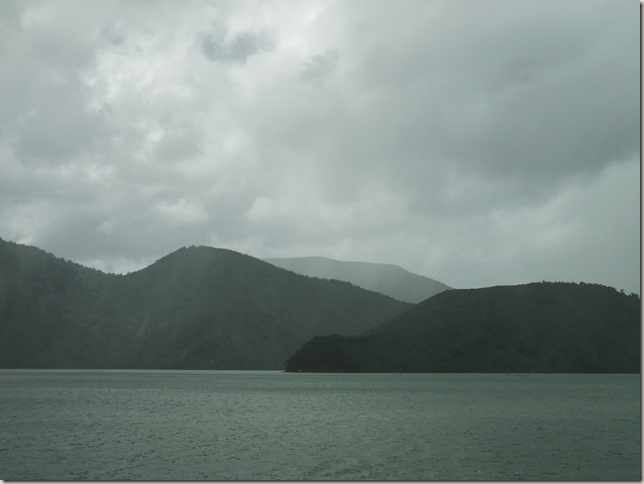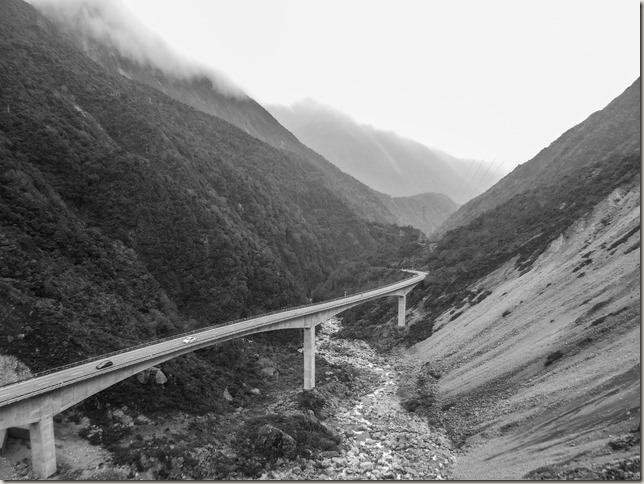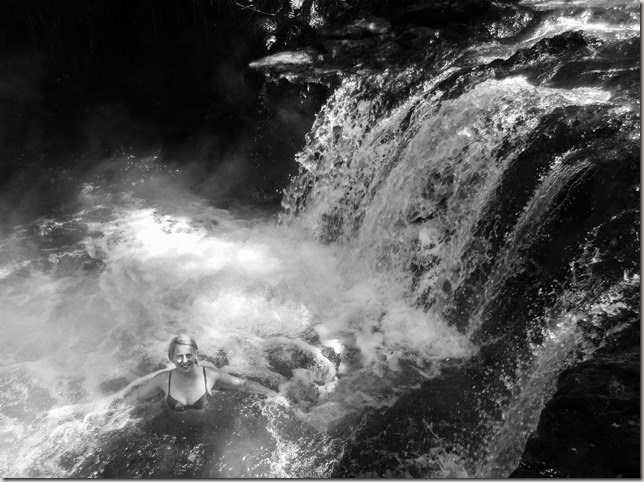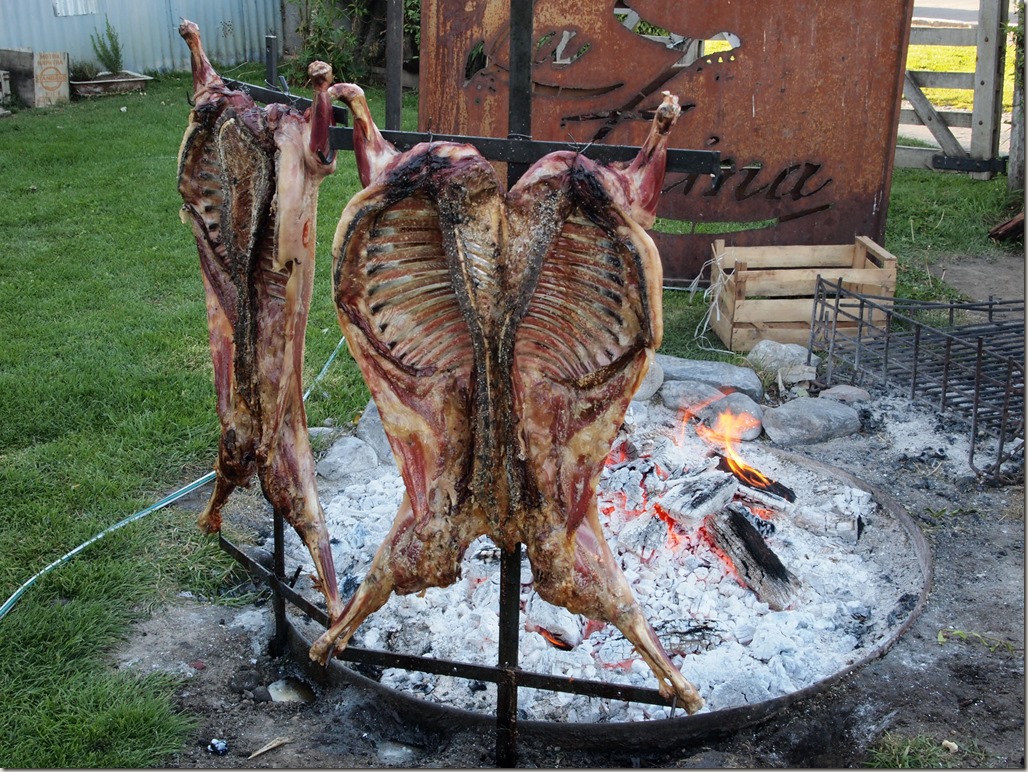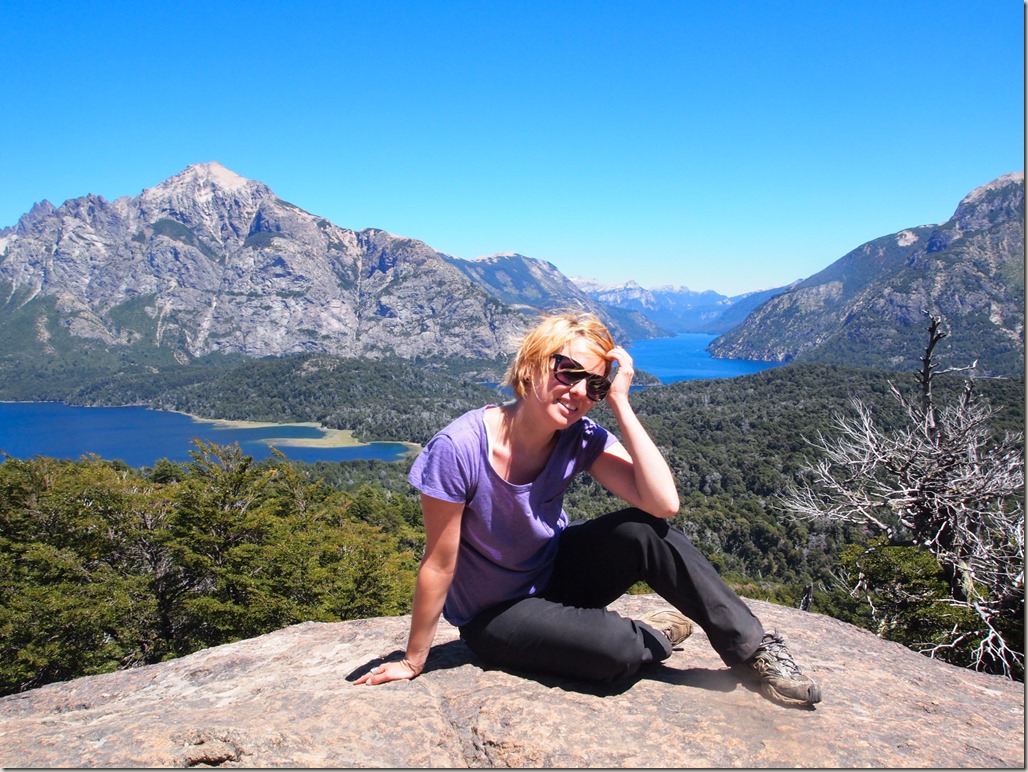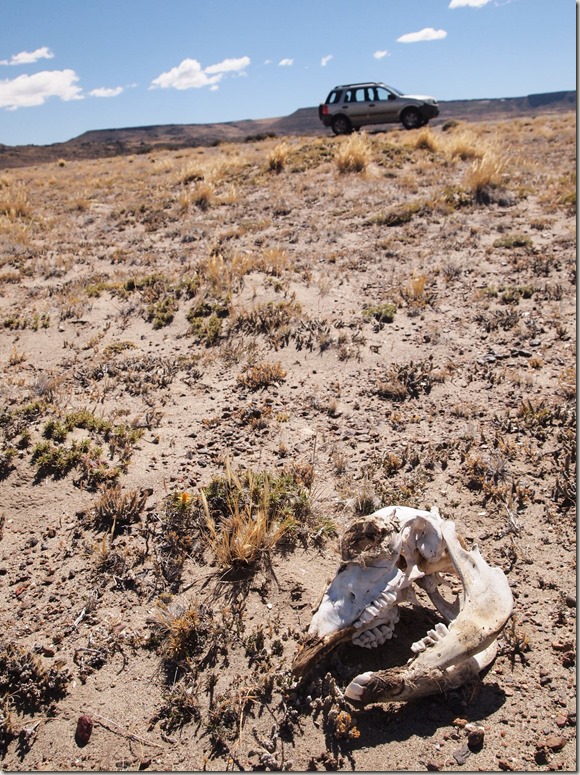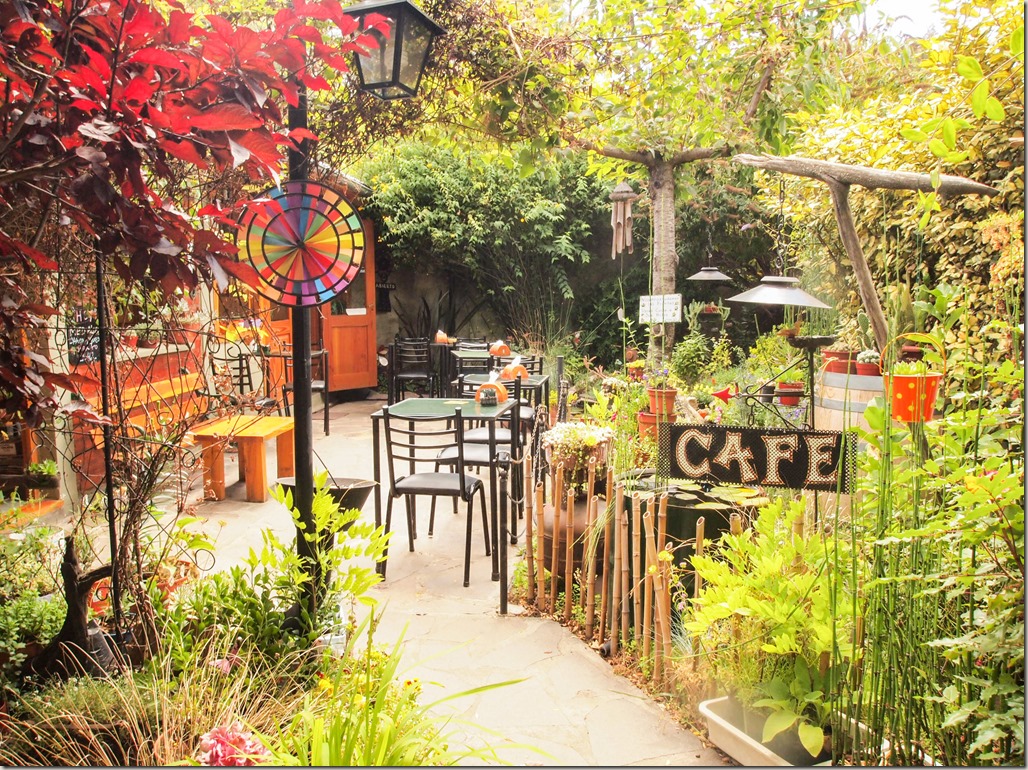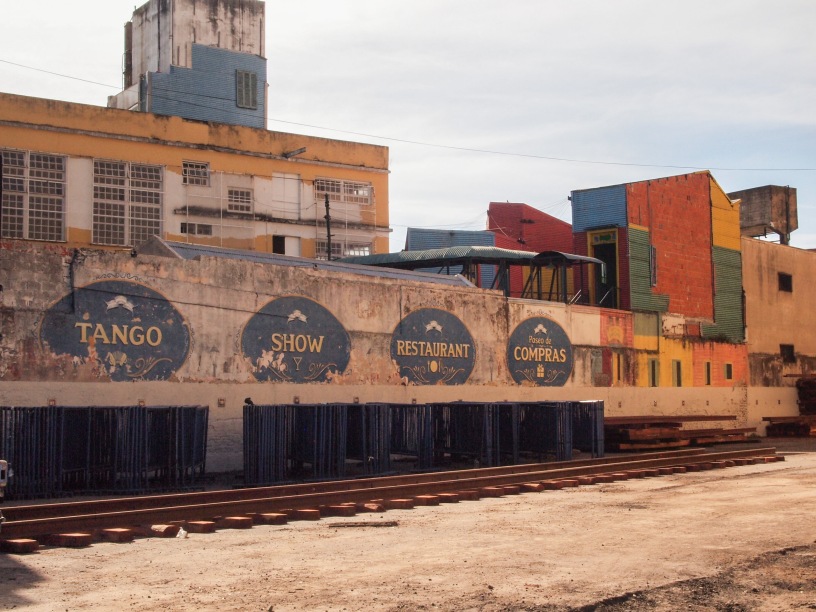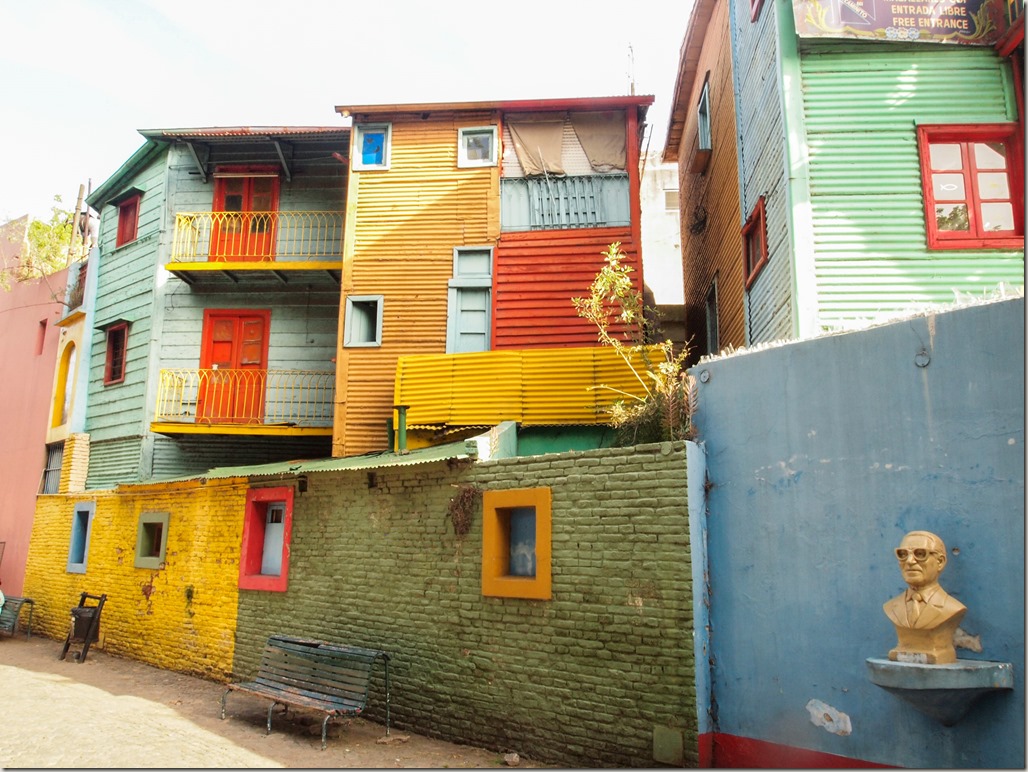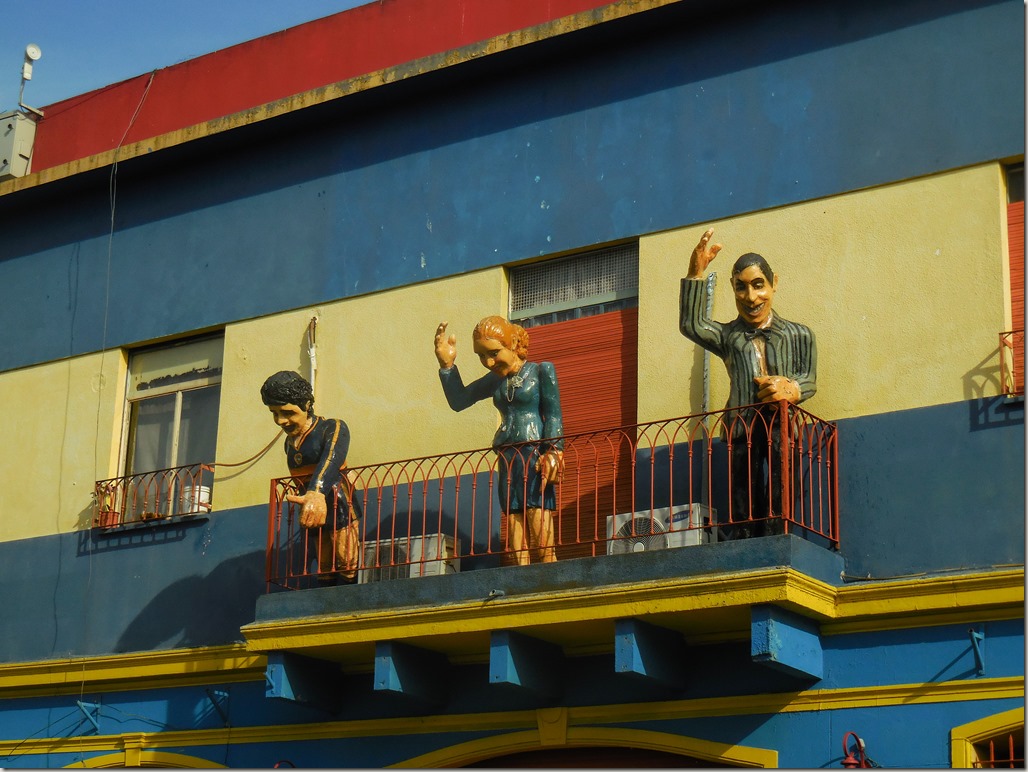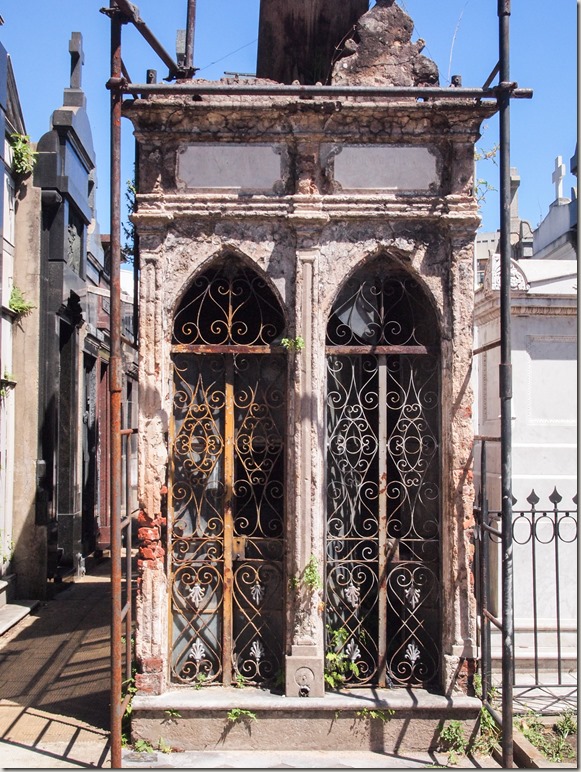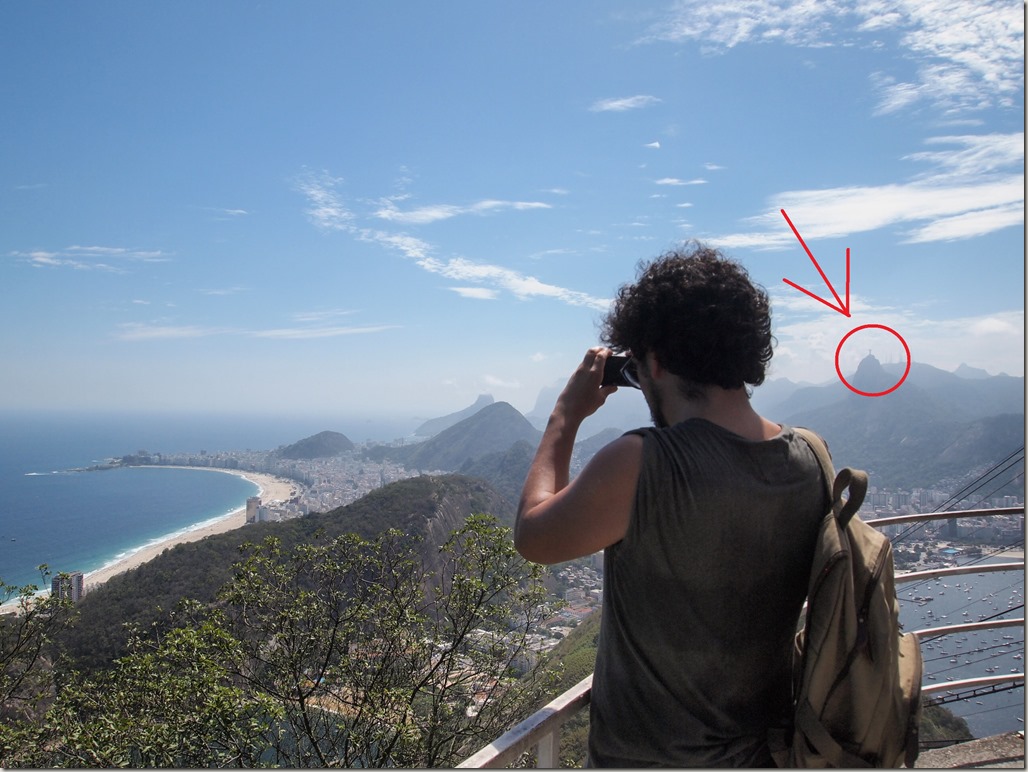Join us as we drive from San Carlos de Bariloche to El Calafate… and back again.
Read our other posts HERE:
Argentina’s infamous Route 40 (or just La Cuarenta) runs down the western edge of the country, alongside the Andes. Starting in La Quiaca in the province of Jujuy it runs some 5,000 km (3,107 miles) north to south, finishing in Cabo Virgenes in Santa Cruz province.
With its notoriously poor surfaces – just dirt and gravel in sections – hairpin bends, and endless straight sections buffeted by violent gusts across the deserted steppe, it is considered one of the world’s most epic drives.

Just your standard view from the driving seat
Unfortunately we didn’t have time to do the whole thing but we were determined to sample a hefty chunk of it. We arrived in San Carlos de Bariloche – the gateway to Patagonia – by plane from Buenos Aires and decided to rent a car to travel down to El Calafate. And then, because the one-way drop-off fees were prohibitively expensive, we would drive all the way back making it a round trip, including detours, of 4000 km (2485 miles) over two weeks.
It’s not the kind of trip where you can just hop in the car and set off. Large stretches of Patagonia are completely deserted and we’d heard horror stories of people who broke down hundreds of miles from the nearest town, people who’d spent the night freezing in their cars in the middle of the steppe with no food, people who’d had their tyres blow only to discover their spare was also flat, fuel tanks pierced by sharp gravel un the unpaved roads… I’m not going to lie, a little part of us wasn’t sure we were cut out for it.
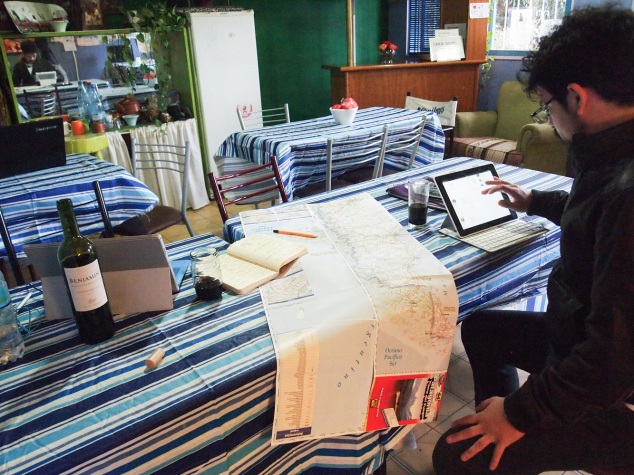
Red wine at the ready as we settle in for a planning sesh
Thanks to some serious research, a couple of precautions and a healthy amount of common sense, we were fine. In fact we had an absolute blast and driving the Ruta 40 remains one of our stand-out experiences of the trip. Of our lives, even. But that’s not to say we didn’t learn things along the way and you do need to be prepared.
Here’s what you need to consider before setting off on a Patagonia Road Trip:
1. What car?
We’d read several accounts that advised against hiring anything but a 4×4 to handle Patagonia’s treacherous roads. Unfortunately this was well out of our budget and so, after a lot of umming and ahhing, we opted for a Ford EcoSport. Even though it’s not a 4×4 (in fact it is very definitely marketed as an “urban car”), it felt sturdier than some of the smaller cars on offer.
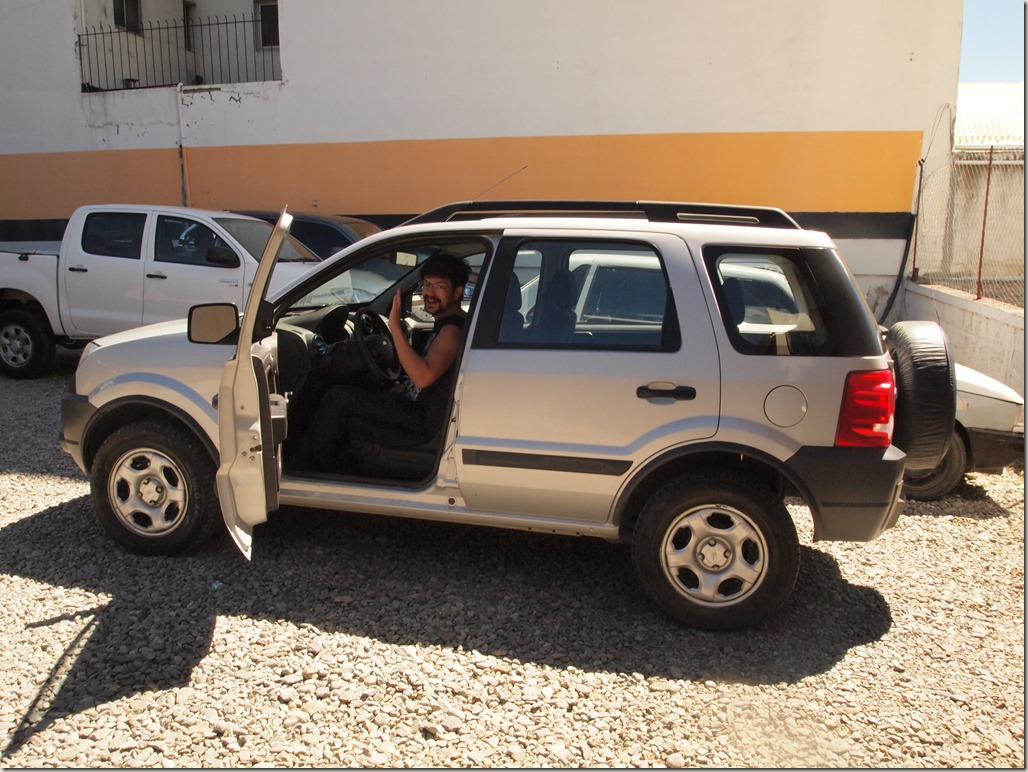
Getting the feel of left-hand drive
That said, having done the drive I would say you could manage it in a compact car. We saw everything on those roads to gigantic off-roaders to rusty old hatchbacks that looked on the verge of falling apart. If you have the money to spend on a 4×4, go for it, I’m sure it would be great fun. But be assured you don’t have to. The only problem you might encounter is car hire companies refusing you certain cars if you tell them you’re planning to take Ruta 40. As far as we could tell, this is for insurance purposes rather than because they don’t think the car could handle it. We’ll therefore leave it to you to decide whether to tell them where you’re going or not (and whether you take out extra insurance). If you want peace of mind, it’s probably best to go with something bigger than urban hatchback.
The “Ecco-port” as they call the Ford EcoSport in Argentina cost us $125/£80 per day from Hertz.
2. The roads
As of February 2015 (when we did the drive) the stretch of Ruta 40 between Bariloche and Calafate is about 80% paved. The only permanently unpaved section runs for 72 km (44 miles) between Lago Cardiel and the tiny hamlet of Tres Lagos.
This particular stretch is rough and uneven, gravel in places, dirt in others. And, if you do it after rain, as we did on the way down, all this is churned to mud, riddled with water-filled ruts. And… it’s great fun. Honestly! We actually came to enjoy the change and the challenge of driving on ripio (gravel).
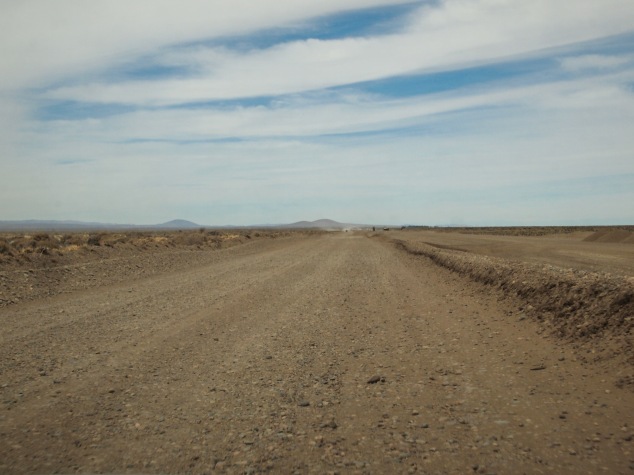
Learn to love the ripio and your drive will be a whole lot smoother (not literally, of course)
Seriously though, as long as you drive carefully and don’t hesitate too long in the muddy sections (we saw a campervan having to be dragged out of one particularly nasty puddle), you shouldn’t have too much of a problem.
The other thing to be aware of is that the paved road itself is pretty worn out in places, full of potholes and frayed edges where the desert has begun to devour it. As a result some of these stretches are being re-paved which may mean an unexpected desvio (diversion) onto gravel tracks. We encountered two of these between Esquel and Rio Mayo, the first lasting for about 20km, the second as we came into, and drove out of Rio Mayo itself.
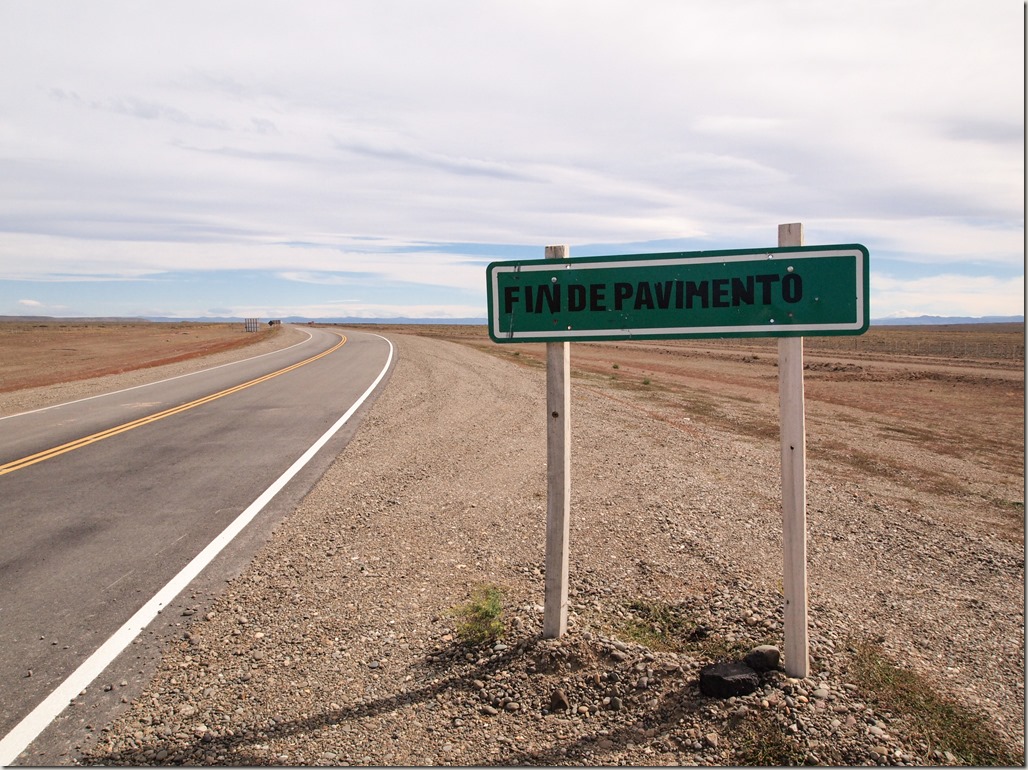
Uh-oh…
When driving on ripio there are two key things to be aware of. Firstly, to avoid skidding on the lose stones, try to stay in the tracks already there. Secondly, watch your speed. Speed limits along these stretches are marked as 40km/h (25mph) but Argentinians pay little attention to speed limits so expect cars to pass you at up to 80km/h (50mph) sending gravel ricocheting in all directions. High speeds increase the risk of both skidding and damage from flying gravel. We found 60km/h (just under 40mph) was about the fastest we felt comfortable going on these sections of road.
3. Potential damage to the car
If you’re researching a trip through Patagonia then like us you’ll have read all sorts of awful stories of burst tyres, cracked windscreens, and pierced fuel tanks. Thankfully we don’t have anything as dramatic to share although we did end up with a whining fan belt after it became embedded with hundreds of tiny stones from the gravelled roads.
When we took it into a garage in Rio Mayo the mechanic disappeared underneath and emerged with a hunk of plastic which he chucked aside saying we didn’t need it. We remain unsure as to what it was but are reasonably convinced that it was protecting the fan belt in some way. It must have got cracked by stones on the ripio, leading to the fan belt getting damaged. To be honest, I’m not sure what we could have done to prevent this. Ultimately it seems like fair wear and tear, particularly on a car that travels this route a lot. And the car still ran fine which is the important thing!
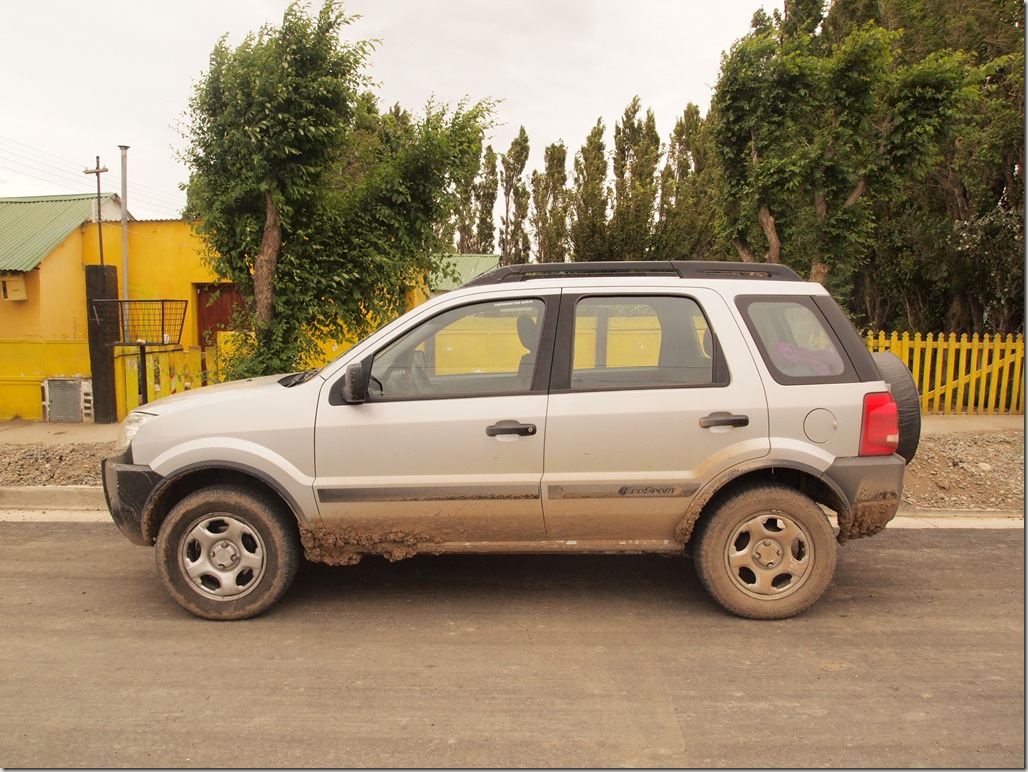
Behold the mighty Ecco-port: muddy but triumphant
The most oft-cited issue for people driving the Ruta 40 is burst tyres. To be honest, as long as you check the tyre pressure before you set off (and in theory the water levels and the oil although most hire cars will have had a once over between rentals anyway) you’ll probably be okay. Many people advocate taking two spare tyres. We only had one. We didn’t need it (and thank goodness, neither of us was exactly relishing the chance to change our first tyre). Go slowly over the ripio and take care on the potholed roads, break up the journey into manageable chunks, and you give yourself the best chance of making it through with tyres intact.
Chipped windscreens and scratches from the gravel seem like a more immediate threat but again, drive carefully and you should be fine. We were given a tip when faced with speedy oncoming or overtaking Argentinians and that was to press your palm against the windscreen as they pass. Apparently the pressure helps prevent it cracking if stones hit the windscreen. We did this for about the first twenty minutes and then got bored.
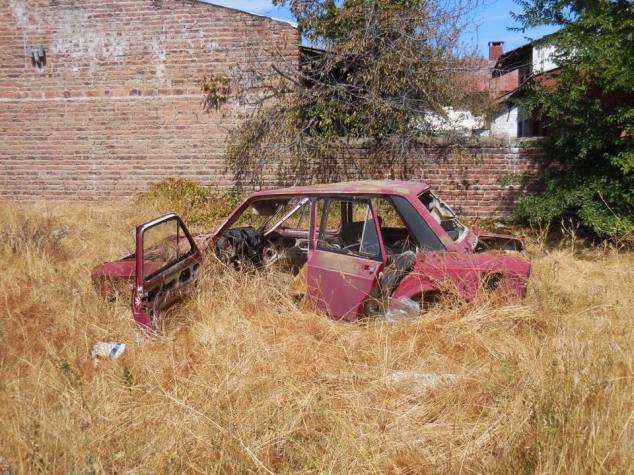
Look on the bright side, it can’t be as bad as this
4. What happens if we break down?
Ok, don’t panic. Yes, Ruta 40 runs through the wilderness, yes there are vast stretches of empty steppe disappearing into the haze, and no, there is no phone signal. But it is not as remote or as untravelled as it once was. Stories that bang on about “not having seen another car for hours” are, in our view, wildly exaggerated. The truth is there are other tourists doing this route and moreover, as the road becomes better, it’s increasingly becoming the thoroughfare of choice for locals. So although there definitely are times where you feel like you’ve got the place to yourself, I think the quietest stretch we had was when we only saw three or four other cars in the space of an hour.
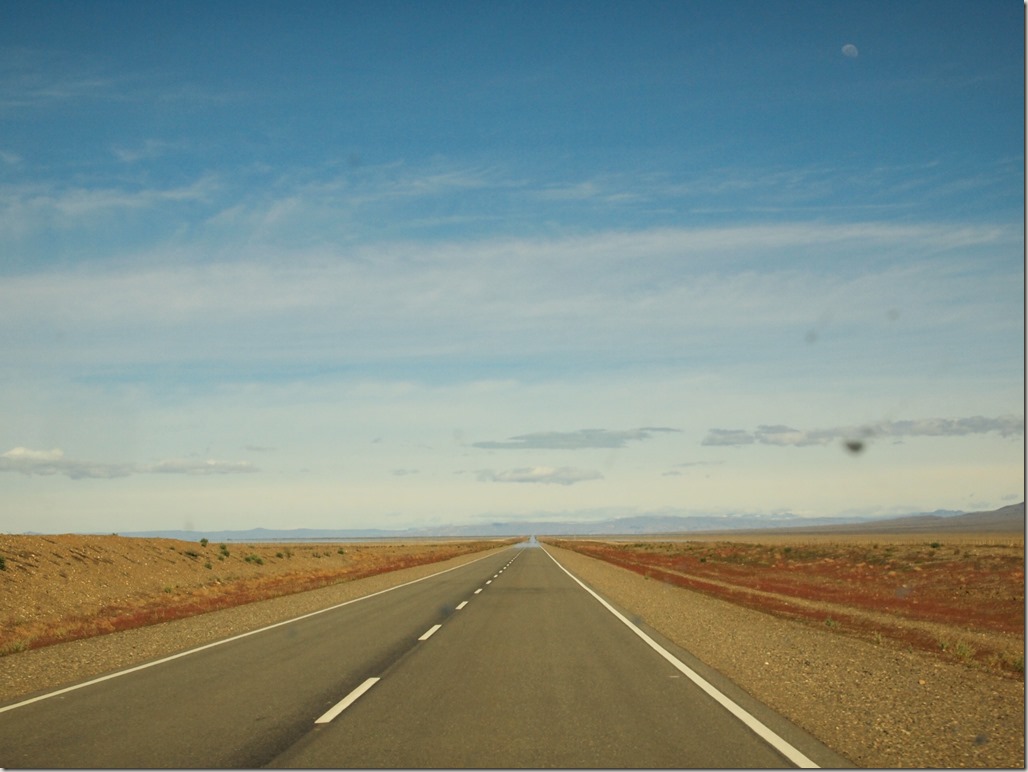
Your view for the next seven hours
In any case, all anyone can really do in this situation is wait and flag somebody down. Everybody on this road knows how remote it is and there is a real feeling of solidarity (people flash their lights to say hello to one another as they pass) so whatever happens, you WILL get help eventually. One piece of advice we read was to bring a blanket or sleeping bag in case you get stranded overnight. To be honest, it seems reasonably unlikely this would be necessary as long as you don’t drive late into the evening. The worst case scenario as far as I can tell would be to abandon the car, hitch a lift to the next town and return with a mechanic either later that day or the next day.
Obviously if you know how to fix the problem yourself and you have the necessary kit, then you’re golden and can continue smugly onto the next point.
5. Food
Fill up the car now because there is not much to eat on the Ruta 40. Anyone entertaining romantic notions of pulling over for an impromptu lamb barbecue in a delightfully rustic Patagonian village can scrap those now. Plus, when there are still 400km between you and the next town, it isn’t always convenient to wait. Likewise going to the loo. We quickly got comfortable with going by the side of the road. There are no trees or bushes to hide behind but really the only thing likely to see you is a guanaco and I’m pretty sure they don’t care.
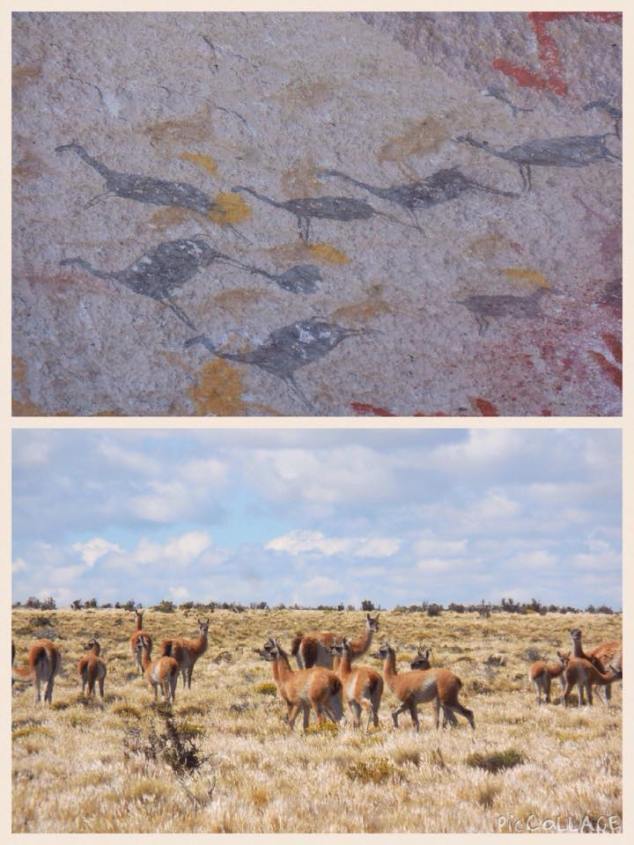
Guanacos: Giving zero fucks since 7300 BC
In the unlikely event that you break down, you definitely do not want to be without provisions so we went for the maximalist approach. We took so much food, we almost didn’t think we’d get through it. In fact at one point we had to turn down hitchhikers because our rear seats were jam-packed with bread rolls, ham, cheese, avocados, tomatoes and cucumber, tinned tuna, crisps, cereal bars, chocolate, fruit…. etc. But get through it we did.
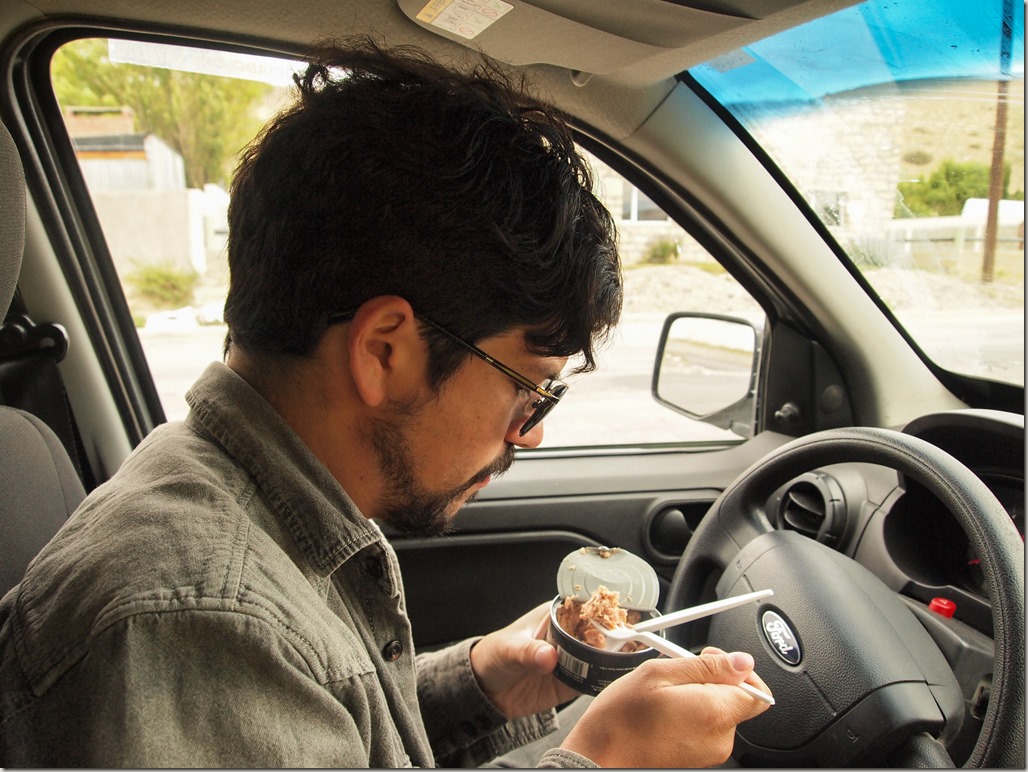
Eating tuna straight from the tin as local cats circle the car (you think I’m joking?)
We also took about ten litres of water and a couple of bottles of red wine (well, we are in Argentina). And I’m sure I don’t need to tell you we got through that as well.
6. Petrol
Fill up the car because there is not much gas on the Ruta 40. The best rule is to top up EVERY TIME you see a petrol station, even if you have three quarters of a tank left, because you don’t know how long it’ll be before you see another.
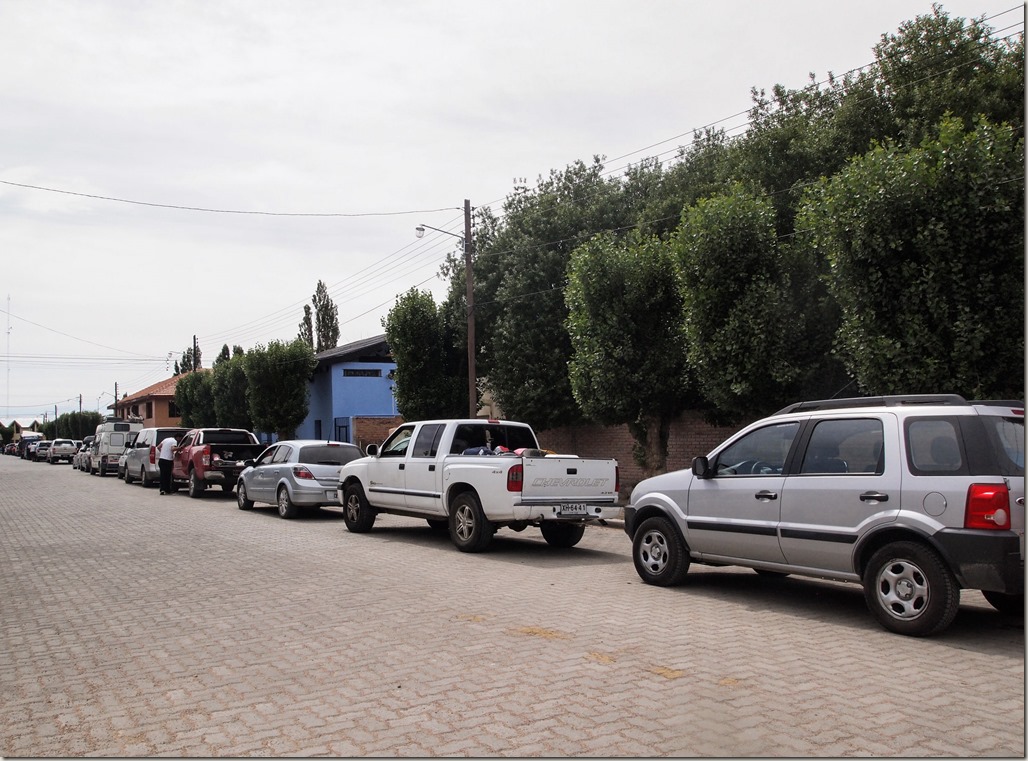
At the beginning of the trip we considered this a long queue. We were wrong.
Yes, even if there’s a queue. We made the mistake of driving on through one town because of the queue for gas only to find an even longer one at the next town.
And never forget that even if a town has a gas station, you always run the risk that it is out of petrol. In Tecka we queued for two hours in a line that went round, not just the block but almost the entire town, before being told that a tanker was on its way from the next city (an hour away) and even after it arrived it would take another hour to refill the pumps and then a further hour to get through everyone in the queue. We still had just under a quarter of a tank left so we made the decision to continue to Esquel, 100km away. We drove at a constant 90km/hr and coasted all the hills to save petrol and thank goodness it worked. We made it with gas to spare but it was an excellent lesson in driving economically.
Here’s where we found petrol stations on the Ruta 40:
- Bariloche
- El Bolson
- Esquel
- Tecka
- Gobernador Costa
- Perito Moreno
- Los Antiguos
- Bajo Caracoles
- Gobernador Gregores
- El Chalten
- El Calafate
Apparently there is also one in Rio Mayo but we couldn’t find it.
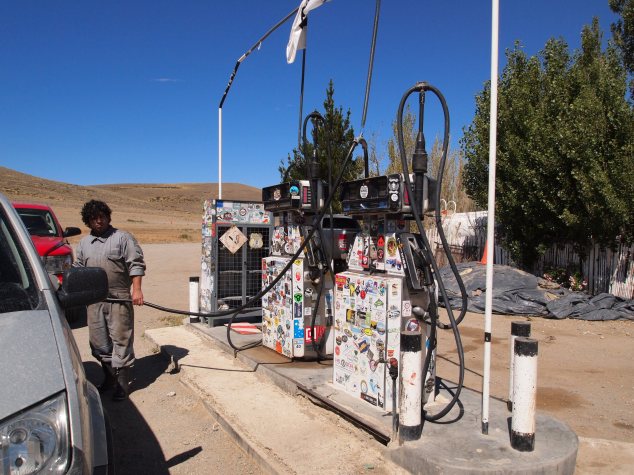
The gas station at Bajo Caracoles, complete with pump attendant
7. Money
Between Esquel and El Calafate the ATMs do not accept foreign cards. I repeat: The cash machines in this 1,160km stretch of Patagonia will not take your card. To withdraw cash here, you have to have an Argentinian current account and corresponding bank card.
In addition, many hotels, supermarkets and restaurants are also unable to take foreign cards because the machines have a problem with the chip in the European “chip and pin” cards (so it’s possible American cards would work, I’m not sure and personally I wouldn’t risk it). This goes for both credit and debit cards.
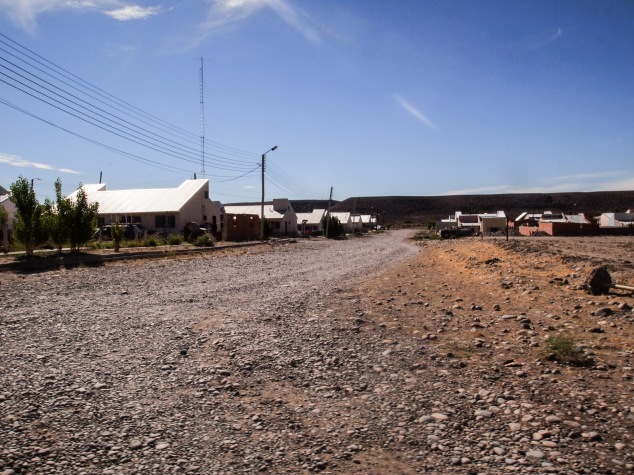
Even if you can find a cash point in Rio Mayo it probably won’t take your card
Consequently it is vitally important to make sure you have enough cash to last you the whole way to El Calafate, where there is a cash machine that does the job. We discovered this the hard way and very nearly had to kip in the car for the night. Luckily our hotel owners were the nicest people in the world and let us give them everything we had on us in a mixture of pesos, dollars and euros and then let us off the remaining amount. Even luckier, we had a car full of food and, crucially at that point, wine (see above).

A much-needed copa de vino after a long day
Now to begin the journey itself! To find out how we broke it up, where we stayed and what we learnt en route, click here:
Driving the Ruta 40: Our Patagonian road trip – Part 1
Driving the Ruta 40: Our Patagonian road trip – Part 2



